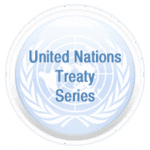EUCLID AS AN INTERGOVERNMENTAL FRAMEWORK: UNTS 49006 AND 49007
Welcome to EUCLIDTREATY.org, the official site of the EUCLID Secretary-General in his capacity as depositary of the intergovernmental agreements that defined and established EUCLID in New York in 2008.
A treaty depositary is a state, international organization, or entity designated to act as the custodian of a treaty. Its primary role is to manage the treaty’s legal and administrative functions, ensuring its proper execution and implementation. Key responsibilities include:
- Receiving and storing the original treaty text.
- Accepting signatures and instruments of ratification, accession, or other expressions of consent to be bound by the treaty.
- Notifying parties of new signatures, ratifications, reservations, or withdrawals.
- Ensuring compliance with the treaty’s procedural requirements, such as entry into force.
- Registering the treaty with international bodies like the United Nations, as required by Article 102 of the UN Charter.
Photo: H.E. Faustin Touadéra as prime minister of the Central African Republic
THE FIRST EUCLID SECRETARY-GENERAL AND DEPOSITARY, H.E. SYED ZAHID ALI (2008-2020)
Syed Zahid Ali is a Pakistani diplomat and the Founding Executive President and first Secretary-General of EUCLID (Euclid University), an intergovernmental organization focused on higher education and sustainable development, registered under UN Treaty Series 49006/49007.
Born in Karachi, Pakistan, Ali developed an early interest in international affairs. He earned a Master’s Degree in International Relations from the University of Karachi, laying the foundation for his career in diplomacy and sustainable development.
Ali’s career began in the late 1990s with roles in consular diplomacy, including work with the Honorary Consulate of Cameroon in Karachi (1998–2006). He was on the Diplomatic Affairs Committee of the Federation of Pakistan Chamber of Commerce and Industry (2003–2005). In 2005, he became Founding President of the Pakistan Society of International Affairs and President of Junior Chamber International Pakistan.
In 2005, Ali was appointed Secretary-General of the International Organization for Sustainable Development (IOSD). He launched the “Euclid” project in 2004/2005, initially a university consortium under IOSD, focusing on sustainable development and diplomacy programs. By 2008, he led EUCLID’s transformationinto an intergovernmental institution, becoming its first Executive President and Secretary-General. As treaty depositary, he oversees EUCLID’s operations and serves on its Executive Board and Oversight Council.
EUCLID'S SECOND SECRETARY-GENERAL, H.E. WINSTON DOOKERAN
Winston Chandarbhan Dookeran (born June 24, 1943, in Rio Claro, Trinidad and Tobago) is a distinguished Trinidadian economist, politician, and international public official. Born to an Indo-Trinidadian family, he graduated from Naparima College and earned a Bachelor of Arts (Honours) in Economics from the University of Manitoba followed by graduate studies at the London School of Economics.
Dookeran’s career blends academia, governance, and international service. He lectured in Economics at the University of the West Indies for fifteen years. Politically, he served as Minister of Planning and Mobilization (1986–1991), acting as Prime Minister during the 1990 coup attempt. He was Governor of the Central Bank of Trinidad and Tobago (1997–2002), Minister of Finance (2010–2012), and Minister of Foreign Affairs (2012–2015) under the People’s Partnership government.
Internationally, Dookeran worked as a Senior Economist at the UN Economic Commission for Latin America and the Caribbean and served on the executive boards of the Inter-American Development Bank and Caribbean Development Bank. Since 2020, he has been Secretary-General of EUCLID (Euclid University), an intergovernmental institution, and is a Professor of Practice at the University of the West Indies.
An accomplished author, Dookeran has published works like Crisis and Promise in the Caribbean (2016) and The Caribbean Quest (1998). His leadership reflects a commitment to economic reform, regional development, and global cooperation.



